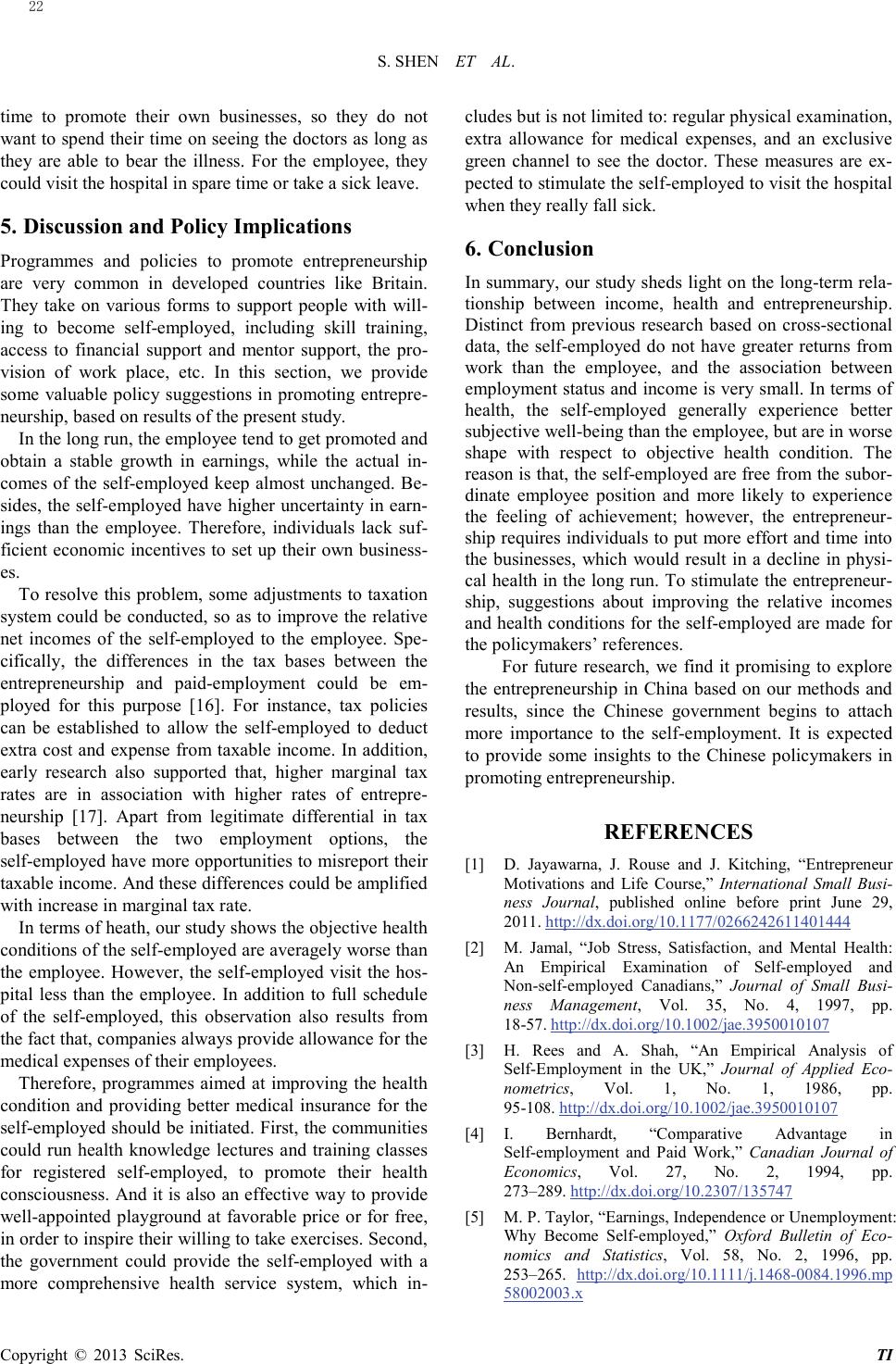
S. SHEN ET AL.
Copyright © 2013 SciRes. TI
time to promote their own businesses, so they do not
want to spend their time on seeing the doctors as long as
they are able to bear the illness. For the employee, they
could visit the hospital in spare time or take a sick leave.
5. Discussion and Policy Implications
Pr o gr a mme s and policies to promote entrepreneurship
are very common in developed countries like Britain.
They take on various forms to support people with will-
ing to become self-employed, including skill training,
access to financial support and mentor support, the pro-
vision of work place, etc. In this section, we provide
some valuable policy suggestions in promoting entrepre-
neurship, based on results of the present study.
In the long run, the employee tend to get promoted and
obtain a stable growth in earnings, while the actual in-
comes of the self-employed keep almost unchanged. Be-
sides, the self-employed have higher uncertainty in earn-
ings than the employee. Therefore, individuals lack suf-
ficient economic incentives to set up their own business-
es.
To resolve this problem, some adjustments to taxation
system could be conducted, so as to improve the relative
net incomes of the self-employed to the employee. Spe-
cifically, the differences in the tax bases between the
entrepreneurship and paid-employment could be em-
ployed for this purpose [16]. For instance, tax policies
can be established to allow the self-employed to deduct
extra cost and expense from taxable income. In addition,
early research also supported that, higher marginal tax
rates are in association with higher rates of entrepre-
neurship [17]. Apart from legitimate differential in tax
bases between the two employment options, the
self-employed have more opportunities to misreport their
taxable income. And these differences could be amplified
with increase in marginal tax rate.
In terms of heath, our study shows the objective health
conditions of the self-employed are averagely worse than
the employee. However, the self-employed visit the hos-
pital less than the employee. In addition to full schedule
of the self-employed, this observation also results from
the fact that, companies always provide allowance for the
medical expenses of their employees.
Therefore, programmes aimed at improving the health
condition and providing better medical insurance for the
self-employed should be initiated. First, the communities
could run health knowledge lectures and training classes
for registered self-employed, to promote their health
consciousness. And it is also an effective way to provide
well-appointed playground at favorable price or for free,
in order to inspire their willing to take exercises. Second,
the government could provide the self-employed with a
more comprehensive health service system, which in-
cludes but is not limited to: regular physical examination,
extra allowance for medical expenses, and an exclusive
green channel to see the doctor. These measures are ex-
pected to stimulate the self-employed to visit the hospital
when they really fall sick.
6. Conclusion
In summary, our study sheds light on the long-term rela-
tionship between income, health and entr ep r e neurship.
Distinct from previous research based on cross-sectional
data, the self-e m pl oyed do not have greater returns from
work than the employee, and the association between
employment status and income is very small. In terms of
health, the sel f -emp loy ed generally experience better
subjective well-being than the employee, but are in worse
shape with respect to objective health condition. The
reason is that, the sel f-e mp loye d are free from the subor-
dinate employee position and more likely to experience
the feeling of achievement; however, the entrepreneur-
ship requires individuals to put more effort and time into
the businesses, which would result in a decline in physi-
cal health in the long run. To stimulate the entrepreneur-
ship, suggestions about improving the relative incomes
and health conditions for the self -e m pl oyed are made for
the policymakers’ references.
For future research, we find it promising to explore
the entrepreneurship in China based on our methods and
results, since the Chinese government begins to attach
more importance to the self-employment. It is expected
to provide some insights to the Chinese policymakers in
promoting entrepreneurship.
REFERENCES
[1] D. Jayawarna, J. Rouse and J. Kitching, “Entrepreneur
Motivations and Life Course,” International Small Busi-
ness Journal, published online before print June 29,
2011. http://dx.doi.org/10.1177/0266242611401444
[2] M. Jamal, “Job Stress, Satisfaction, and Mental Health:
An Empirical Examination of Self-employed and
Non-self-employed Canadians,” Journal of Small Busi-
ness Management, Vol. 35, No. 4, 1997, pp.
18-57. http://dx.doi.org/10.1002/jae.3950010107
[3] H. Rees and A. Sh ah, “An Empirical Analysis of
Self-Employment in the UK,” Journal of Applied Eco-
nomet r ics, Vol. 1, No. 1, 1986, pp.
95-108. http://dx.doi.org/10.1002/jae.3950010107
[4] I. Bernhardt, “Comparative Advantage in
Self-employment and Paid Work,” Canadian Journal of
Economics, Vol. 27, No. 2, 1994, pp.
273–289. http://dx.doi.org/10.2307/135747
[5] M. P. Taylor, “Earnings, Independence or Unemployment:
Why Become Self-employed,” Oxford Bulletin of Eco-
nomics and Statistics, Vol. 58, No. 2, 1996, pp.
253–265. http://dx.doi.org/10.1111/j.1468-0084.1996.mp
58002003.x